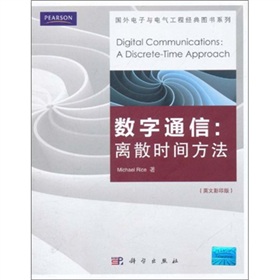数字通信:离散时间方法 电子书下载 PDF下载

内容简介
《数字通信:离散时间方法(英文影印版)》运用离散信号处理的原则来介绍和分析数字通信,连接了实时和离散方式,注重理论与实践相结合。涵盖了离散信号处理、离散滤波器设计、多速率处理及估计理论,并提出了基于离散信号的空间分析、数值算法。《数字通信:离散时间方法(英文影印版)》可作为电子信息工程、通信工程专业本科生教材,也可作为相关领域工程技术人员的参考书。
·查看全部>>
目录
Foreword
Preface
Chapter 1 Introduction
1.1 A Brief History of Communications 1
1.2 Basics Of Wireless Communications 10
1.3 Digital Communications 12
1.4 Why Discrete-Tune Processing Is So Popular 14
1.5 Organization of the Text 19
1.6 Notes and References 22
Chapter 2 Signals and Systems 1:A Review of the Basics
2.1 Introduction 23
2.2 Signals 24
2.2.1 Continuous-Time Signals 24
2.2.2 Discrete-Time Signals 26
2.3 Systems 28
2.3.1 Continuous-Time Systems 28
2.3.2 Discrete-Time Systems 29
2.4 Frequency Domain Characterizations 30
2.4.1 Laplace Transform 32
2.4.2 Continuous-Time Fourier Transform 37
2.4.3 Z Transform 40
2.4.4 Discrete-Time Fourier Transform 46
2.5 The Discrete Fourier Transform 50
2.6 The Relationship Between Discrete-Time and Continuous-Time Systems ~ 55
2.6.1 The Sampling Theorem 56
2.6.2 Discrete-Time Processing of Continuous-Time Signals
2.7 Discrete-Time Processing of Band-Pass Signals 67
2.8 Notes and References 70
2.9 Exercises 71
Chapter 3 Signals and Systems 2: Some Useful Discrete-Time Techniques for Digital Communications
3.1 Introduction 114
3.2 Multirate Signal Processing 115
3.2.1 Impulse-Train Sampling 115
3.2.2 Downsampling 118
3.2.3 Upsampling 120
3.2.4 The Noble Identities 122
3.2.5 Polyphase Filterbanks 122
3.3 Discrete-Time Filter Design Methods 127
3.3.1 IIR Filter Designs 129
3.3.2 FIR Filter Designs 134
3.3.3 Two Important Filters:The Differentiator and the Integrator 149
3.4 Notes and References 159
3.5 Exercises 159
Chapter 4 A Review of Probability Theory
4.1 Basic Definitions 178
4.2 Gaussian Random Variables 188
4.2.1 Density and Distribution Functions 188
4.2.2 Product Moments 192
4.2.3 Functions of Random Variables 193
4.3 Multivariate Gaussian Random Variables 195
4.3.1 Bivariate Gaussian Distribution !96
4.3.2 Linear Operators and Multivariate Gaussian Random Variables 197
4.4 Random Sequences 198
4.4.1 Power Spectral Density 199
4.4.2 Random Sequences and Discrete-Time LTI Systems 200
4.5 Additive White Gaussian Noise 202
4.5.1 Continuous-Time Random Processes 202
4.5.2 The White Gaussian Random Process:A Good Model for Noise? 204
4.5.3 White Gaussian Noise in a Sampled Data System 206
4.6 Notes and References 208
4.7 Exercises 208
Chapter 5 Linear Modulation 1: Modulation, Demodulation, and Detection
Chapter 6 Linear Modulation 2: Performance
Chapter 7 Carrier Phase Synchronization
Chapter 8 Symbol Timing Synchronization
Chapter 9 System Components
Chapter 10 System Design
AppendixA Pulse Shapes
Appendix B The Complex-Valued Representation for QAM
Appendix C Phase Locked Loops
Bibliography
Preface
Chapter 1 Introduction
1.1 A Brief History of Communications 1
1.2 Basics Of Wireless Communications 10
1.3 Digital Communications 12
1.4 Why Discrete-Tune Processing Is So Popular 14
1.5 Organization of the Text 19
1.6 Notes and References 22
Chapter 2 Signals and Systems 1:A Review of the Basics
2.1 Introduction 23
2.2 Signals 24
2.2.1 Continuous-Time Signals 24
2.2.2 Discrete-Time Signals 26
2.3 Systems 28
2.3.1 Continuous-Time Systems 28
2.3.2 Discrete-Time Systems 29
2.4 Frequency Domain Characterizations 30
2.4.1 Laplace Transform 32
2.4.2 Continuous-Time Fourier Transform 37
2.4.3 Z Transform 40
2.4.4 Discrete-Time Fourier Transform 46
2.5 The Discrete Fourier Transform 50
2.6 The Relationship Between Discrete-Time and Continuous-Time Systems ~ 55
2.6.1 The Sampling Theorem 56
2.6.2 Discrete-Time Processing of Continuous-Time Signals
2.7 Discrete-Time Processing of Band-Pass Signals 67
2.8 Notes and References 70
2.9 Exercises 71
Chapter 3 Signals and Systems 2: Some Useful Discrete-Time Techniques for Digital Communications
3.1 Introduction 114
3.2 Multirate Signal Processing 115
3.2.1 Impulse-Train Sampling 115
3.2.2 Downsampling 118
3.2.3 Upsampling 120
3.2.4 The Noble Identities 122
3.2.5 Polyphase Filterbanks 122
3.3 Discrete-Time Filter Design Methods 127
3.3.1 IIR Filter Designs 129
3.3.2 FIR Filter Designs 134
3.3.3 Two Important Filters:The Differentiator and the Integrator 149
3.4 Notes and References 159
3.5 Exercises 159
Chapter 4 A Review of Probability Theory
4.1 Basic Definitions 178
4.2 Gaussian Random Variables 188
4.2.1 Density and Distribution Functions 188
4.2.2 Product Moments 192
4.2.3 Functions of Random Variables 193
4.3 Multivariate Gaussian Random Variables 195
4.3.1 Bivariate Gaussian Distribution !96
4.3.2 Linear Operators and Multivariate Gaussian Random Variables 197
4.4 Random Sequences 198
4.4.1 Power Spectral Density 199
4.4.2 Random Sequences and Discrete-Time LTI Systems 200
4.5 Additive White Gaussian Noise 202
4.5.1 Continuous-Time Random Processes 202
4.5.2 The White Gaussian Random Process:A Good Model for Noise? 204
4.5.3 White Gaussian Noise in a Sampled Data System 206
4.6 Notes and References 208
4.7 Exercises 208
Chapter 5 Linear Modulation 1: Modulation, Demodulation, and Detection
Chapter 6 Linear Modulation 2: Performance
Chapter 7 Carrier Phase Synchronization
Chapter 8 Symbol Timing Synchronization
Chapter 9 System Components
Chapter 10 System Design
AppendixA Pulse Shapes
Appendix B The Complex-Valued Representation for QAM
Appendix C Phase Locked Loops
Bibliography
同类热门电子书下载更多
Copyright © 2025 by topbester.com.
All Rights Reserved.
沪ICP备14027842号-1
All Rights Reserved.
沪ICP备14027842号-1